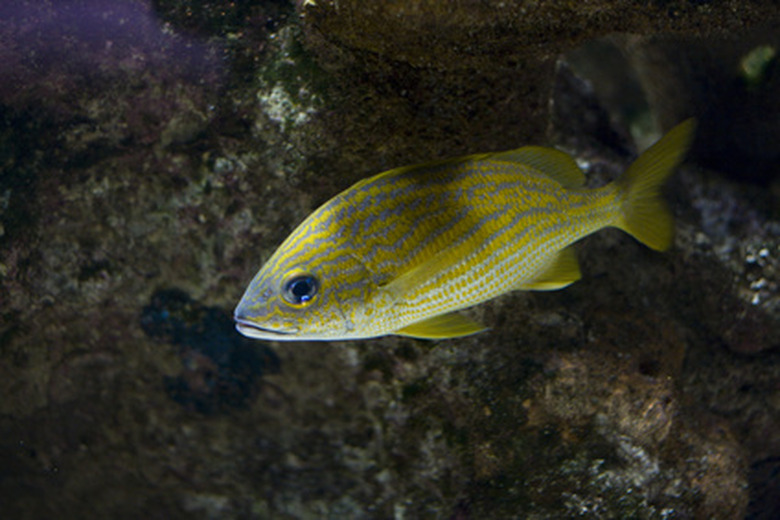The Reproductive System Of Fish
All life forms have the drive to reproduce, but the reproductive system of fish has some unique features. To reproduce, fish have to produce the eggs and sperm required for sexual reproduction. They then have to bring the eggs and sperm together for fertilization. Finally, they have to produce the young fish. Different species of fish have different methods of carrying out these three tasks in ways that ensure fertilization takes place and as many young as possible survive. The way these fish breeding methods have evolved highlights how the reproduction of fish is extremely varied and complex.
TL;DR (Too Long; Didn't Read)
The reproduction of fish takes different forms for different species. Some scatter a large number of eggs and sperm in the water together and hope that enough eggs are fertilized and that the young survive. Others give birth to live young, either hatching the eggs inside the mother's body or feeding the young inside the mother via a placenta. A few hatch the fertilized eggs inside the parents' mouths, and the young fish stay protected there until they are big enough to be self-sufficient. For most fish, once the young are hatched or born, they are on their own. The reproductive strategy of fish is to produce as many young as possible so that a few may survive to become adults.
The Reproduction of Fish
The Reproduction of Fish
All fish have internal sexual organs, and some have evolved external organs as well. Female fish have ovaries that produce eggs while male fish have testes that produce sperm. The next step is fertilization, and different species use different methods to make sure fertilization takes place consistently. Since fish reproduce sexually, if eggs are not fertilized, they don't produce any young.
Many species of fish don't really mate in the sense mammals do. The female scatters the eggs her ovaries have produced into the water, and the male ejects his sperm into the water in the same general area. The key to the success of this method is scattering lots of eggs and sperm so the chances of a sperm finding an egg in the water and fertilizing it are high.
Some fish species produce fewer eggs and have developed methods to make sure the few eggs are fertilized. For these fish, the males have specialized fins or body protrusions that can deliver sperm to a specific area on the female fish. The females have oviducts that lead from the ovaries to the outside, and the sperm swim up the oviduct to reach the eggs. To ensure they always have sperm available for fertilization, some female fish species have the ability to store the sperm for several egg-laying cycles.
For fish using internal fertilization of the eggs, the fertilized eggs may remain inside the mother fish and hatch internally. In this case, the young hatchlings are either released by the mother at the time of hatching or they remain inside the mother for an additional period during which they are fed from a placenta in the mother's body. A final method of ensuring the survival of the young is for the parents to take the fertilized eggs into their mouths until the eggs hatch. The young can then continue to live inside the parents' mouths until they are big enough to become independent.
Fish Reproduction Classifications
Fish Reproduction Classifications
Fish species can be classified by how they reproduce. Three main categories are fish that lay eggs, fish that nourish the hatched young inside the mother's body with a placenta and fish that hatch the eggs inside the mother's body and then release them. Scientists use Latin-based words for these classifications. For example, ovi is Latin for eggs and parous means to bear or reproduce. To define oviparous using the Latin meanings gives "egg-bearing," or the class of fish that lays eggs.
In the same way, vivus is Latin for alive, so viviparous means "live-bearing," or the class of fish producing live offspring that have been nourished by the mother's placenta. Fish using a mixture of these methods, in which the eggs hatch inside the mother and are then released, are called ovoviviparous, or egg-laying live-bearing fish.
How fish reproduce and the corresponding classifications are important because more and more fish species are being farmed for food. Fish breeding is an important source of revenue for many countries, and farmed fish is a healthy food alternative to meat or wild-caught fish that are becoming scarce. Knowing how they reproduce is a key to raising them successfully.
Cite This Article
MLA
Markgraf, Bert. "The Reproductive System Of Fish" sciencing.com, https://www.sciencing.com/reproductive-system-fish-6725214/. 22 November 2019.
APA
Markgraf, Bert. (2019, November 22). The Reproductive System Of Fish. sciencing.com. Retrieved from https://www.sciencing.com/reproductive-system-fish-6725214/
Chicago
Markgraf, Bert. The Reproductive System Of Fish last modified March 24, 2022. https://www.sciencing.com/reproductive-system-fish-6725214/
